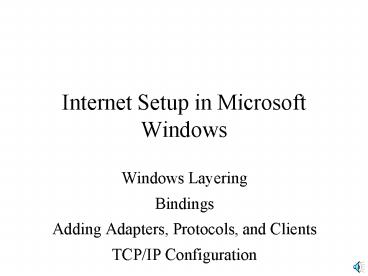Internet Setup in Microsoft Windows - PowerPoint PPT Presentation
1 / 17
Title:
Internet Setup in Microsoft Windows
Description:
Clients set up Windows to be a client for a particular type of file server. Services set up Windows to make a ... Windows Layering vs. TCP/IP-OSI. Adapters ... – PowerPoint PPT presentation
Number of Views:136
Avg rating:3.0/5.0
Title: Internet Setup in Microsoft Windows
1
Internet Setup in Microsoft Windows
- Windows Layering
- Bindings
- Adding Adapters, Protocols, and Clients
- TCP/IP Configuration
2
Windows Layering vs. TCP/IP-OSI
3
Windows Layering vs. TCP/IP-OSI
- Clients and Services
- For file service
- Clients set up Windows to be a client for a
particular type of file server - Services set up Windows to make a users PC
provide file and print services for other PCs on
the network - Very limited not for file servers on large PC
networks
4
Windows Layering vs. TCP/IP-OSI
- Protocols
- Combination of transport and internet layer
protocols - TCP/IP is only one possibility
- IPX/SPX for Novell NetWare servers Microsoft
sometimes calls this NW Link - NetBEUI for some Microsoft servers on small PC
networks
5
Windows Layering vs. TCP/IP-OSI
- Adapters
- Combination of data link layer and physical layer
protocols - The subnet layers
- Dial-Up adapter sets up a modem and PPP
- Other adapters, including Ethernet for a
network interface card (NIC)
6
Bindings
- Bindings
- After add clients, services, protocols, and
adapters, must bind the combinations that will
work together
Client for MS Windows
Other Added Client
Binding
IPX/SPX Protocol
TCP/IP Protocol
Binding
Ethernet Adapter
Dial-Up Adapter
7
Bindings
- Bindings
- Bindings create communication paths between
adjacent layer processes
Client for MS Windows
Other Added Client
Binding
IPX/SPX Protocol
TCP/IP Protocol
Binding
Ethernet Adapter
Dial-Up Adapter
8
Configuring Networking in Windows
- In Windows 95 and Windows 98,
- Go to the Start Button
- Choose Settings
- Choose Control Panel
- Double click the Network icon
- This opens the Network Dialog Box
9
The Network Dialog Box
- Be sure the Configuration tab is selected
- You will see adapters, protocols, clients, and
services that have already been added - Operations
- Add To add an adapter, protocol, client, or
service - Remove To remove one
- Properties To see or change the properties of
the selected adapter, protocol, client, or service
10
The Network Dialog Box
- The Add Button
- Clicking the Add button takes you to the Select
Network Component Type dialog box - Choose client, protocol, adapter, or service,
then hit Add - Assume you chose protocol You then go to the
Select Network Protocol dialog box - Other choices will take you to the relevant
Select Network dialog box
11
The Network Dialog Box
- Select Network Protocol Dialog Box
- Click on a manufacturer to see the protocols it
offers then click on the specific protocol - Hit OK to add the protocol from files on your
hard drive or Have Disk if you have a disk
containing the protocol - The selected protocol will be added
- The Select Network Client, Service, and Adapter
dialog boxes work the same way
12
The Network Dialog Box
- To configure a protocol after adding it
- Go to the Network Dialog Box
- Click on the target protocol, etc.
- Click on the Properties button below it
- A dialog box specific to that protocol, etc. will
appear - This will allow you to configure the protocol,
etc.
13
The TCP/IP Properties Box
- To configure TCP/IP
- Click on TCP/IP on the Configuration tab of the
Network Dialog Box - Click on the Properties button below it
- This opens the TCP/IP Properties dialog box
- The TCP/IP Properties dialog box has multiple tabs
14
The TCP/IP Properties Box
- By default, the IP Address tab is shown when you
open the TCP/IP Properties Dialog Box - There are two radio buttons allowing you to
either - Specify an IP address or
- Obtain an IP address automatically
15
The TCP/IP Properties Box
- Specify an IP address
- Type in your PCs permanent IP address
- Type in your local subnet mask (discussed in
Chapter 3) - Also, on other tabs, setup other parameters
- Gateway (default router)
- DNS Configuration
- Bindings
16
The TCP/IP Properties Box
- Specify an IP address
- Gateway IP address router to send packets to if
no other router is specified Gateway is the old
name for router - DNS Configuration Enable or disable DNS, enter
DNS hosts IP address and IP address of backup
DNS host - Bindings bindings between the TCP/IP protocol
and clients/services and adapters
17
The TCP/IP Properties Box
- Obtain IP address automatically
- Asks a DHCP autoconfiguration host for a
temporary IP address - Also obtains most other configuration information
from the autoconfiguration host as well - Almost always the best choice for client PCs































